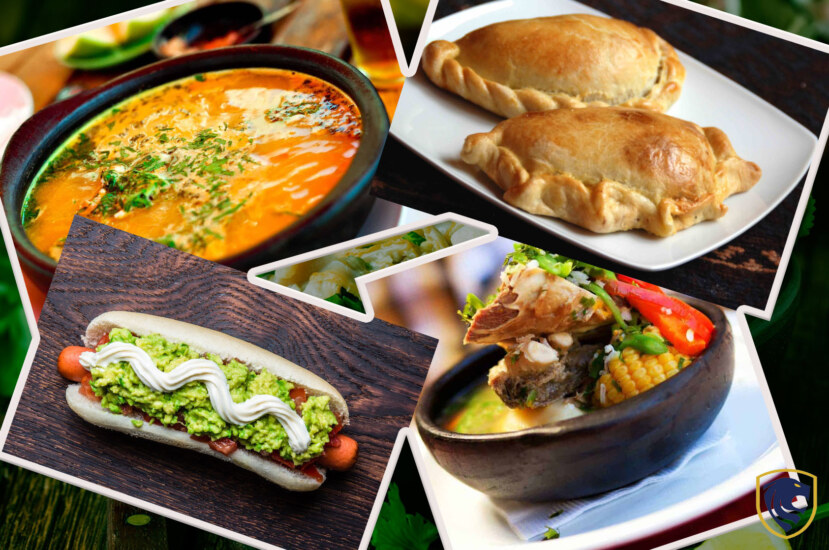A gastronomic experience unlike any other can be had in Chile, a country known for its varied landscapes and rich cultural heritage. In harmony with regional variety, Spanish influences, and indigenous flavors, Chilean cuisine is nestled between the Pacific Ocean and the imposing Andes Mountains. It is a cuisine that has developed over many years. It reflects the history of the nation and the creativity of its citizens. Traditional meals in Chile are a reflection of the country’s rich culture and diverse terroir. It ranges from the northern deserts to the southern fjords. We dig into the core of Chile’s culinary tradition in this gourmet adventure, revealing a tapestry of dishes that tantalize the palate and capture the spirit of this alluring South American country.
Every mouthful is a voyage through history and culture, providing a window into Chile’s character and the gastronomic wonders it has to offer. So let’s go on a gourmet journey to explore the finest Chilean cuisine, which entices you with every savory fragrance and mouthwatering mouthful.
Chilean Empanadas
Empanadas from Chile are a treasured gourmet treat that perfectly encapsulates Chilean cuisine in a compact pastry pocket. These meaty hand pies are a staple of Chilean cuisine. Flaky pastry shells that are frequently fried to a golden perfection wrap tasty fillings in empanadas. Ground beef, onions, black olives, raisins, and a piece of hard-boiled egg are some of the traditional fillings. But Chile provides a wide range of ethnic and inventive fillings. For instance, there can be shrimp, cheese, mushrooms, and even hot sauces. Chilean empanadas come in a variety of regional variations. In the north, Pino, a combination of ground beef, onions, and spices, is frequently used to make empanadas. Empanadas with cheese, cheese, and seafood filling are common in the southern regions.

Chilean Empanadas; Exploring the Culinary Delights of Chile
Not only are Chilean empanadas tasty. But they are also highly adaptable. They frequently appear during picnics, family reunions, and other events, such as Chile’s Independence Day, where they take center stage. Chilean empanadas are mostly eaten hot and straight from the oven with a side of pebre, a fiery salsa consisting of tomatoes, onions, and cilantro. In Chile, empanadas are more than simply food. They stand for a link to the nation’s lengthy history and wide variety of culinary customs. Anyone wanting a genuine experience of Chilean culture and flavor must sample these delicious hand pies.
Cazuela
A beloved Chilean dish called cazuela is evidence of the nation’s diverse culinary heritage and its blending of indigenous and European influences. Also, it is a dish with colonial origins and has grown to be a favorite comfort food for Chileans. The origins of this filling soup may be found with the advent of the Spanish conquistadors in Chile. They brought their culinary customs, which merged with local products and preparation techniques. Moreover, Cazuela became a well-liked meal throughout time as it adapted to the regional ingredients and flavors of Chile.

Cazuela
Cazuela’s simplicity is what gives it appeal. Usually, a hearty broth is cooked with soft bits of meat (usually chicken or beef), potatoes, corn on the cob, pumpkin, and rice. The soup’s characteristic flavor comes from the broth, which is seasoned with a mixture of native Chilean herbs. Cazuela might differ from area to region in Chile, yet the essential components are always the same. While lamb or other game meats are frequently included in the southern Patagonian area, seafood may be added to dishes in the northern deserts. In Chile, cazuela is a mainstay of both formal occasions and regular family meals. Cazuela, when served boiling, provides sustenance, comfort, and a strong link to Chile’s culinary history.
Indulging in a warm bowl of cazuela is essential for everyone who wants to learn more about Chilean culture via its food. It is a dish that not only warms the body but also the soul, really capturing the essence and roots of Chilean cuisine.
Chorrillana
The delicious Chilean delicacy chorrillana was created in the crowded streets of Santiago, the nation’s capital. The history of chorrillana is entwined with Chilean urban culture. Also, it has gained its reputation as a popular and filling food. The development of chorrillana may be dated to the middle of the 20th century when it first appeared in Santiago’s neighborhoods. Its invention is sometimes credited to “La Piojera,” a well-known neighborhood bar known for providing this delectable combination to thirsty customers. The meal is straightforward yet filling, with a bed of golden, crispy french fries heaped liberally on a platter. A tasty mixture of sautéed onions and thinly cut beef strips, frequently seasoned with herbs and spices like cumin and paprika, are placed on top of the fries.

Chorrillana
The chorrillana is topped with a fried egg. Its thick yolk gives the food creaminess and richness. Ketchup and occasionally a hot chili sauce are used alongside this finishing touch to give chorrillana a flavorful kick. A social event, chorrillana is more than just a supper. It’s a go-to option for late-night social events with friends or for soothing a raging hunger after a night of celebration. With its ability to provide both nutrition and a feeling of community, chorrillana serves as a representation of Chilean urban culture.
Curanto
The southern region of Chile has the island of Chiloé, where the current is a typical cuisine with rich cultural roots. Curanto has roots in the native Chono people and was further impacted by Spanish settlers. It is an example of how different cultural and culinary traditions can coexist. The name “curanto,” which means “hot stone” in Mapuche, is said to have originated there. This refers to the technique of preparing this collective feast, which requires heating stones.

Curanto
To prepare Curanto, a pit must be dug in the earth and heated with hot stones. On the hot stones, layers of food are arranged, including seafood, potatoes, meat (such as pig, poultry, and sausages), and vegetables. The ingredients are frequently covered with banana or nalca leaves to create a natural steam chamber. Curanto is a social celebration rather than only a meal. As the food cooks, groups of friends and family assemble around the current pit to contribute ingredients and swap stories. It is a long-standing custom that fosters community. Curanto varies depending on the location of Chile. While pigs and sausages are the main attractions in certain regions, seafood is the headliner in others.
Curanto is a must-try for anybody looking for a genuine flavor of Chilean culture and cuisine. It is a tasty and fragrant experience that highlights the island’s lengthy history and its people’s ingenuity. Curanto enjoyment is more than just savoring a meal. It also involves participating in a long-standing custom that keeps people connected to their heritage.
Pastel de Choclo
A well-known Chilean delicacy called pastel de choclo has a mouthwatering flavor combination that honors the nation’s long culinary tradition. The native Mapuche cuisine is the source of this famous Chilean pastel de choclo, which was later influenced by Spanish colonial immigrants. In Spanish, “pastel de choclo” means “corn pie.” Its origins may be found in the Mapuche civilization of pre-Columbian times, where maize was a common meal. Pastel de choclo is one of the several meals that the Mapuche people made from maize. The meal has a stuffing of ground beef, onions, raisins, black olives, and a piece of hard-boiled egg. The sweet corn topping, which is made by combining fresh corn kernels with basil leaves and milk, is what distinguishes pastel de choclo from other desserts.

Pastel de Choclo
Pastel de choclo has a unique flavor profile due to the contrast between the salty beef filling and the sweet corn topping. The corn topping is usually cooked on the pie until it turns brown and somewhat crunchy. It is especially well-liked during Fiestas Patrias, Chile’s national festival, and is regarded as a national treasure. It’s a dish that unites families, and cooking it is frequently a team effort. You are experiencing a piece of Chilean history and culture when you savor a piece of pastel de choclo. It’s an exquisite blend of flavors that honors the native Mapuche people while highlighting the traditions of Spanish colonial times.


